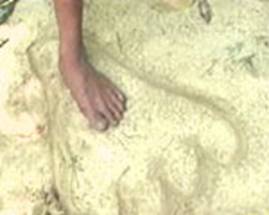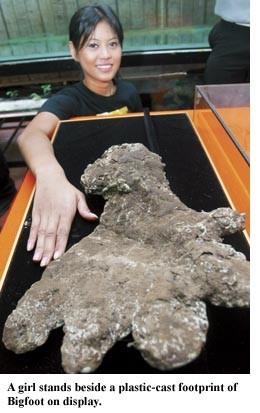A Track Is Not A Foot
Posted by: Loren Coleman on February 28th, 2006
Today, guest contributor Mark A. Hall, author of books on cryptozoology, the inventor of the concept of True Giants, and the editor of Wonders, shares his thoughts on the Malaysian evidence of four-toed tracks.
+++++++++++++++++++++++++++++++++
I have looked over the record of tracks for True Giants after all these impressions from Malaysia have been published.

One of the first four-toed track photographs from Malaysia, December 2005.
We are always learning more about these creatures. We know they have a mammalian limb so a fifth toe was once a part of their limbs, and it still might show up as it appears to be there at the back of these several tracks. In one of the impressions there appears to be a small side extension that could result from something stepped upon at that one spot. So that single cast is not a key indicator of how a foot might be constructed. (That is the much-pictured Joshua Gates imprint.)

Several points:
The True Giant tracks show four prominent toes and a fifth toe was either not showing or not as obvious in many imprints examined in North America. Of course, I would have liked to have had the budget and the foresight to know which of the scores of tracks were most vital to have examined them in person, but that did not happen and we have to go with the second hand and imperfect record (often a poor visual record) of the North American tracks. When we look for it, there are indications in the past record of a fifth toe appearing on the inside of the foot.
I am sending along a photo (below) from the Corinth, Mississippi, episode where we can see a possible indication of a fifth toe in that location on the foot.
We are looking at populations widely separated geographically so that the position of the fifth toe might be different in the many parts of the world where these giants occur. They seem to be remarkably widespread, as I was indicating in the third edition of Yeti, Bigfoot, and True Giants.
The photos you have marked "Orang Pendek" cause me to caution that it might be misleading when people tack that label on everything that turns up in Sumatra. Much as people have put "Bigfoot" on everything in North America. We have to be ready to make distinctions. And keep learning.
I would prefer to look at these issues over time and see what evidence can be found to support this take on the tracks. But the modern age is not so gentile. I want to share what I know, and these are my preliminary views on the new evidence and how it may well fit in with the known history of True Giants.

The image is a photograph by Lee Ann Taylor that appeared in Tennessee’s Memphis Commercial Appeal for March 23, 1976.
A dispatch from Corinth, Mississippi, tells of finds in Alcorn County.
The footprints — nearly 15 inches long and 6 inches wide and most with four toes — were first discovered March 14 along Smith Bridge Road north of US 72.
Since then, more tracks have been reported at two churches and one graveyard on the southern side of the highway 12 miles west of here [Corinth].
About Loren Coleman
Loren Coleman is one of the world’s leading cryptozoologists, some say “the” leading living cryptozoologist. Certainly, he is acknowledged as the current living American researcher and writer who has most popularized cryptozoology in the late 20th and early 21st centuries.
Starting his fieldwork and investigations in 1960, after traveling and trekking extensively in pursuit of cryptozoological mysteries, Coleman began writing to share his experiences in 1969. An honorary member of Ivan T. Sanderson’s Society for the Investigation of the Unexplained in the 1970s, Coleman has been bestowed with similar honorary memberships of the North Idaho College Cryptozoology Club in 1983, and in subsequent years, that of the British Columbia Scientific Cryptozoology Club, CryptoSafari International, and other international organizations. He was also a Life Member and Benefactor of the International Society of Cryptozoology (now-defunct).
Loren Coleman’s daily blog, as a member of the Cryptomundo Team, served as an ongoing avenue of communication for the ever-growing body of cryptozoo news from 2005 through 2013. He returned as an infrequent contributor beginning Halloween week of 2015.
Coleman is the founder in 2003, and current director of the International Cryptozoology Museum in Portland, Maine.










Dear Mark–Thank you for your warning against labeling everything hominid or unknown-primate from Sumatra as “orang pendek.” A recent article here described the “orang pendek” footprint as being “pongid,” with a thumb-like opposable big toe. Orang pendek sightings, however, indicate an erect bipedal hominid, which COULD be a _Homo erectus_ or an australopithecine, rather than a pongid.–T. Peter
Should the top photo be used in this discussion? I’m asking because it seems like an obvious hoax. The body of the footprint doesn’t seem to make an impression in the ground at all – the only part below the level of the rest of the ground is the outline, which seems traced in the ground. Something that would be large enough to make a footprint that size would leave a fairly deep depression. Seems like a fairly overt hoax to me. Anyone else concur?
The casting and the bottom print seem more believable, although I see problems with the bottom print too. The area around the bottom two toes seems strange – there’s no impression connecting them to the main track. Could be the lighting or an artifact of the biomechanics of how the track was made, but it seems off.
And just to clarify, in the other thread I wasn’t claiming that the recent casts are Orang Pendek, just that they were vaguely similar – like a distant relative – because they also had four main toes. (The configuration of a fifth toe or possible fifth toe are different in each case.)
I have to say, those first two “footprints” smack of one of two things: a hoax or Big Bird, LOL. I have no doubt there is a Sasquatch-like creature in Malaysia, but those “footprints” do not resemble in any way actual tracks at all. They are most likely either a hoax or rhinoceros tracks somehow lumped together.
I agree with mrbf2006 & shovethenos, that first print is ludicrous, and the second one is questionable as well.
I’ve always been wary of the ‘Zoobie’ type prints. I mean, at least lets filter down to something that looks more hominid.
Such splay-footed tracks remind me of Orangutan prints; the one with the girl’s hand beside it could well be an Orangutan print, with a little shifting in the mud or earth as it was made. Equally plausible is a doubled up or distorted rhino print.
I’ve had some experience with Orangutans. Males can become *extremely* large – their feet and hands quite able to match the scale we’re seeing here, and although knuckle-walkers and thus unlikely to be the source of upright hominid reports in these areas, it wouldn’t surprise me if there were some Orangutan prints mixed in with this other evidence.
The Orangutan foot has an almost vestigial thumb, so it might, under the right conditions, give rise to a four-toed print with no sign of the fifth toe. The remaining Orangutan toes are rather long and slender, though, often ‘clawed’ with very strong nails.
I have to agree with shovethenos. The top photo is the WORST hoaxed photo I have ever seen. I don’t know what kind of footprints those are but I don’t think they are Bigfoot tracks. If they are then something is very wrong with him.
The top photo is not a photo of a hoaxed footprint, nor is it an actual footprint. It was a drawing in the sand by the five-year-old female witness who was lost in the Lenggor National Park for six days while searching for rattan with her family in December. She said that while she was lost, she had seen a large “King Kong” with huge arms and covered with black fur. She was interviewed by ChannelNewsAsia.com and she drew in the sand with a stick the outline of the tracks that she had seen. It is obviously an exaggeration, but a hoax, I think not. Here is a link to an article with her account.
All footprints shown on the different photo’s are quite huge and for sure I wouldn’t like to be the one meeting this “creature” in the forest. I hope that if they really exist, we will leave them in peace and not turn this thing into a money-making circus. There are many ancient stories of huge “man-apes” in Asian history and you see these creatures depicted in Thailand on the wall of the Grand Palace and also in Indonesia where one of these famous man-apes is called Ano-man. I think there is far more to these stories than just folklore. The fact that people find footprints all over the world means that a creature of this size still being undetected for sure is a highly intelligent creature. Natural history as we know it, is completely wrong anyway. Huge humanlike footprints were found near the Paluxy river dating 140 million years ago (see the photo’s in Eric von Danicken’s book) and at this very moment there’s a Chinese tracker hunting for a Chinese Bigfoot seen by him in some remote area of China. Also in Russia there are stories of people who took a shot at “Bigfoot looking” creatures. So even though there is still doubt wether they are for real, I don’t think footprints in the cold Himalayas were made by a skater-MTV-wannabee star from California who was bored on a Sunday afternoon.
Craig-
Thanks for the clarification. Someone might have mentioned that before too. Maybe it would be a good idea to attach a small caption explaining the picture’s origin whenever it is posted to avoid any confusion.
The first foot print is definitely a drawing in SAND.
BG